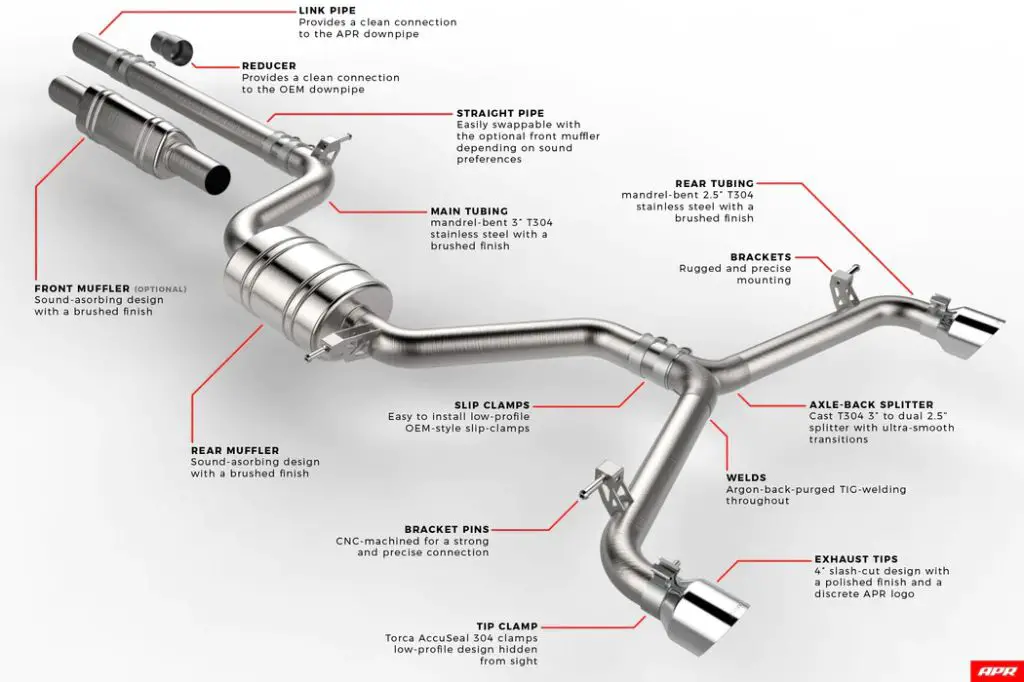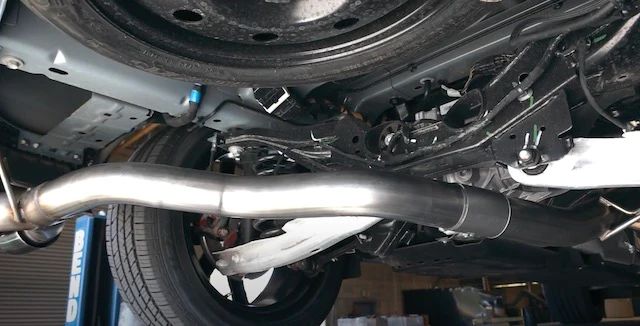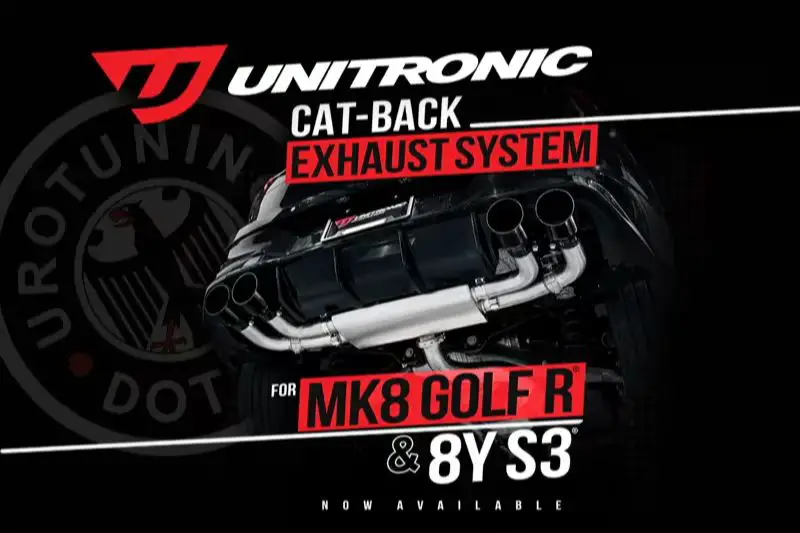What is a Cat Back Exhaust System?
A cat-back exhaust system refers to the portion of the exhaust system from the catalytic converter back. It includes the pipes, mufflers, and tips that make up the rear section of the exhaust system.
The main components of a cat-back exhaust system are:
- Mid pipe – connects to the outlet of the catalytic converter
- Muffler – reduces noise from the exhaust gases
- Tail pipes – carry exhaust gases from the muffler to the tips
- Exhaust tips – the visible end pipes where exhaust gases exit
Upgrading to a cat-back exhaust system offers several benefits over a stock exhaust system:

- Increased horsepower and torque – reducing exhaust backpressure improves engine efficiency[1]
- Better fuel economy – more efficient exhaust flow can increase MPG
- Enhanced engine sound – gives a deeper, more powerful exhaust tone
- Customizable look – aftermarket tips allow you to customize the visual style
Overall, installing a cat-back upgrade is one of the easiest ways to unlock more performance and customize the style of your vehicle.
Purpose of the Catalytic Converter
The catalytic converter is an emissions control device that is installed in the exhaust system of virtually every gasoline engine vehicle produced after 1975. Its purpose is to reduce the harmful pollutants emitted from the engine’s exhaust.
Inside the catalytic converter is a honeycomb-shaped structure coated with precious metal catalysts, usually platinum, palladium, and rhodium. As the exhaust gases pass through, the catalysts facilitate chemical reactions that convert harmful compounds like carbon monoxide, hydrocarbons, and nitrogen oxides into less toxic substances like carbon dioxide, water vapor, and nitrogen.
Specifically, the catalytic converter serves three main functions:
- Oxidizes carbon monoxide and hydrocarbons into carbon dioxide and water vapor
- Reduces nitrogen oxides into nitrogen and oxygen
- Oxidizes unburnt hydrocarbons into carbon dioxide and water vapor
By converting these pollutants into harmless compounds, the catalytic converter plays a crucial role in reducing the environmental and health impacts of vehicle emissions. This is why it is required by federal law in the United States and most countries around the world as an essential emissions control device on all gasoline-powered vehicles.
Without a properly functioning catalytic converter, the emissions from a vehicle would contain much higher levels of pollutants that contribute to smog, acid rain, and respiratory problems.

Sources:
https://www.synchrony.com/blog/automotive/what-is-a-catalytic-converter-and-why-do-we-need-it.html
https://www.uti.edu/blog/automotive/catalytic-converter
Do All Cat Back Exhausts Have a Catalytic Converter?
Stock cat back exhaust systems that come from the factory will always include a catalytic converter. The catalytic converter is a critical emissions control device that helps reduce pollution from the vehicle’s exhaust. By law, all production vehicles must have a working catalytic converter.
However, aftermarket cat back exhaust systems may or may not include a catalytic converter. Some performance-oriented systems are designed without a cat in order to reduce restrictions in the exhaust and allow more power. But removing the catalytic converter will cause the vehicle to fail emissions testing in most areas.
So whether an aftermarket cat back exhaust has a catalytic converter really depends on the specific exhaust system. Some brands offer both catted and catless versions of their exhausts. It’s important to check the product details to confirm if a catalytic converter is included or not before purchasing an aftermarket cat back exhaust system.
Source: https://www.quora.com/Do-cat-back-exhaust-system-needs-catalytic-converter
Benefits of Removing the Catalytic Converter
Removing the catalytic converter can provide some performance benefits for your vehicle’s engine and exhaust system. Some of the main benefits include:
Increased exhaust flow and horsepower – The catalytic converter creates backpressure in the exhaust system which restricts exhaust flow and robs engine power. Removing the cat eliminates this restriction allowing for freer breathing exhaust and more usable horsepower from the engine 1.
Louder exhaust tone – The catalytic converter muffles and dampens the exhaust tone. Removing it creates a more aggressive and louder exhaust sound which many performance enthusiasts prefer.
Reduced exhaust backpressure – Lower backpressure decreases resistance against the engine allowing it to operate more efficiently. It also reduces heat levels in the engine and exhaust system 1.
Downsides of Removing Catalytic Converter
While removing the catalytic converter can provide some benefits like increased horsepower and a better exhaust sound, there are also some downsides to be aware of:
One major downside is increased emissions. The catalytic converter reduces pollutants like hydrocarbons, carbon monoxide and nitrogen oxides. Removing it will significantly increase the emission of these harmful gases into the environment (Car and Driver). This can contribute to smog and have a negative environmental impact.
You may also run into legal issues depending on local regulations. Many areas have laws prohibiting the removal of catalytic converters. Getting caught driving without one could result in hefty fines (Green Garage Blog).
Additionally, your check engine light will likely come on with the catalytic converter removed. This is because the oxygen sensor detects the change in emissions and triggers an error code. You’ll have to clear the code, which will keep coming back on unless the converter is replaced (Car Bibles).
How to Tell if Cat Back Has Catalytic Converter
There are a few ways to determine if a cat back exhaust system still has the catalytic converter intact:
Look for the catalytic converter housing in the piping. The catalytic converter is typically contained in a separate bulbous chamber along the exhaust piping. If you see this distinct housing, chances are the cat is still there.
Check the manufacturer’s product specifications. The product details from the manufacturer will indicate if their cat back exhaust retains the factory catalytic converter or replaces it with a high flow pipe. This is the most definitive way to verify.
Note any extra weight compared to a non-cat exhaust. catalytic converters use precious metals that add extra weight versus a straight pipe or muffler. If your cat back exhaust feels significantly heavier than a regular aftermarket muffler system, the original catalytic converter is likely still installed.
Overall, visually inspecting for the catalytic converter housing and verifying with the manufacturer specs are the best ways to determine if your cat back exhaust came equipped with the factory catalytic converter. According to one forum (https://www.reddit.com/r/cars/comments/4zz0p4/how_do_i_check_if_my_exhaust_is_decat_or_not/), you can also have a muffler shop verify if the catalytic converter is intact.
Installing a Cat Back Exhaust System
Installing a cat back exhaust system is a straightforward process, but does require some mechanical skills, tools, and safety precautions. Here is an overview of the installation steps:

You’ll need an automotive jack, jack stands, basic hand tools like wrenches, sockets, pliers, and screwdrivers. Safety glasses and work gloves are also recommended. Make sure to let the exhaust fully cool before starting work. Have the new cat back exhaust system on hand before beginning.
Start by jacking up the vehicle and properly supporting it with jack stands. Apply penetrating oil to all exhaust fastener bolts and fittings to loosen them, let it soak in for 10-15 minutes. Remove the OE exhaust system starting from the rear, detaching all mounts, hangers and pipe connections. Temporary support the exhaust if needed while disassembling.1
Test fit the new cat back exhaust, adjusting components for proper alignment and fit. You may need to cut or expand some pipes. Then begin installing the new system from back to front, attaching all mounts, hangers and connections. Leave all clamps and bolts slightly loose for adjustments.
With the new exhaust fully seated, verify alignment and tighten all clamps, nuts and bolts to spec. Check for leaks and rattles. Lower the vehicle and take it for a test drive. Retighten everything after the first drive when cool. Enjoy the new cat back exhaust!
Maintenance Tips
Proper maintenance of your cat back exhaust system is essential to keep it operating efficiently and protect against corrosion or leaks. Here are some key maintenance tips:
Inspect all clamps and hangers regularly. Clamps can loosen over time due to heat cycles and engine vibration, potentially resulting in detachment or exhaust leaks. Check that all clamps are tight and secure. Also inspect rubber isolators and hangers for deterioration or cracking, and replace if needed. As per https://theengineblock.com/clearing-the-air-exhaust-system-maintenance-and-upkeep, inspecting clamps and hangers is an important first step.
Check for exhaust leaks. Listen for any hissing sounds near clamps or joints which may indicate an exhaust leak. Exhaust leaks can decrease performance and allow harmful fumes into the cabin. Seal any leaks or replace components as needed. As recommended by https://aamcocentralflorida.com/exhaust-system-maintenance, inspecting for leaks helps avoid issues.
Clean exhaust tips regularly. Use a chrome or metal polish to clean discoloration or dirt buildup on visible exhaust tips. This keeps them looking fresh and new. Avoid harsh abrasives. As discussed on https://bobistheoilguy.com/forums/threads/how-to-keep-new-cat-back-exhaust-rust-free.161625/, cleaning and protecting the surface helps minimize rust and corrosion.
Popular Brands
Some of the most popular brands for cat back exhaust systems include:
Borla
Borla is one of the best-known manufacturers of cat back exhaust systems and is popular for their stainless steel systems which provide excellent durability and performance (Thomasnet). Borla offers the S-Type and ATAK product lines featuring trademarked multi-core technology for maximized airflow.
Flowmaster
Flowmaster is known for producing cat back systems that provide an aggressive exhaust tone. Their Force II system features mandrel-bent tubing to reduce backpressure. Flowmaster also offers Powercore and Delta Flow technologies across different product lines (CarParts).
MBRP
MBRP is a leading brand offering cat back systems made from aluminized steel or T304 stainless steel. Their XP series features slash cut tips and MBRP’s proprietary sound cancellation technology for a refined muscle car sound.
Finding the Right Cat Back Exhaust
When shopping for a cat back exhaust system, there are a few key factors to consider:
First, determine your needs and set a budget. Are you looking for improved performance, a deeper exhaust note, or both? Cat back systems range widely in price from a couple hundred dollars for basic kits to over a thousand for premium brands. Set realistic expectations for what you can afford.
Next, ensure the system you select properly fits your vehicle. Carefully research dimensions, inlet and outlet sizes, and hangers to verify compatibility. Most manufacturers provide comprehensive fitment guides. For example, see Summit Racing’s how-to guide for choosing the right exhaust system.
Finally, listen to sound clips to decide on the volume and tone you prefer. Cat back systems dramatically alter the exhaust note, from mild to aggressive. Be realistic about loudness limits based on your area’s laws. You want an exhaust you enjoy, not one that gives you headaches.
By considering your budget, research fitment thoroughly, and selecting the right sound, you can find the perfect cat back exhaust to customize your vehicle.


